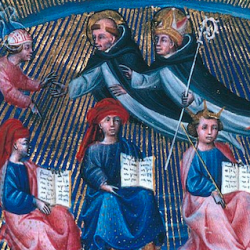Lectionary Reflection
John 10:1-18
May 15, 2011
In the Sunday School Room
In the Sunday school room of the church I attended as a child, there was that picture of Jesus with a lamb on his shoulders on the back wall. After a while I didn't really see it anymore. It was just a pleasant portrait on the back wall of our room. There it remains to the present day, in my mind and memory, a hazy, pleasant background picture of Jesus I thought was just meant to be comforting for children.
Unfortunately, that placement and purpose is the exact opposite of the way this image functions in the Gospel of John. It was meant to be at the forefront of readers' minds and it was not just intended to comfort. My colleague Roy Heller, who teaches Old Testament at SMU's Perkins School of Theology, often warns his classes not to "confuse familiarity with understanding." That warning came to mind this time when I read John 10:1-10, the passage about Jesus as Good Shepherd. It turns out that the Good Shepherd is not an image intended to comfort children. It is an image intended to inspire the faith of adults in difficult times. It is an image meant to counter forces that would isolate them from each other and undermine their faith in Christ.
In the first-century House Church
Suppose you time traveled back 20 centuries from that Sunday school room to one of the house churches to which John wrote his gospel. You've been evicted from the synagogue. Maybe you've stayed in Palestine despite the opposition to your faith from Jewish authorities. Maybe you've left Palestine to get away from the conflicts. In either case, you're meeting in a small group praying for strength to withstand popular opposition to your faith. Your brow is probably furrowed.
And then you hear the leader read this passage in which Jesus promises, "I am the Good Shepherd."
From previous worship services you remember other "I am" sayings. Jesus is the bread, the light, a path, a gate, a vine. Your heart is made more peaceful in remembering that Jesus fulfills the necessities of life, providing for your basic physical, emotional and spiritual needs.
If you were a Jewish Christian, these images would have helped you hold onto your heritage, even though you've been evicted from the synagogue because of your belief in Jesus. Your manna in the wilderness has become Jesus, the Bread of Heaven. Your light, symbol of the law, is now identified with Messiah to whom the Torah bore witness. The way promised to the one who follows God's wisdom and law is now identified with Jesus the Way (Koester 233; see below for full reference.) And the shepherd, a common sight across the ancient Mediterranean world and a common metaphor for leadership, is now Jesus the Good Shepherd.
John's Gospel always addresses readers in the plural. These texts were meant to be read aloud in group worship. They are wonderful examples of effective oral communication, brief, colorful, and memorable. In times of testing and persecution, in geographically isolated, small communities of believers, these brief, bold affirmations of Jesus' identity enabled them to hold onto their common faith.
"I am the Good Shepherd" is one of seven "I am" sayings by which John portrays Jesus' identity to the house churches to whom he wrote near the end of the first century. He was writing to a number of communities both in Palestine and beyond. It may be that some Christians moved beyond Palestine because of conflicts with Jewish authorities. This may partly account for John's theme of "scattering" (10:12; 16:32) (Koester, 227). Conflict with the synagogues took the form of attempts to discredit Christian claims about Jesus. Jesus' miracles were those of a charlatan (7:12; 10:10-19). His teaching lacked credibility (7:40-52). A crucified Messiah was ridiculous (12; 34). Jesus' claim to unity with God was a blasphemous challenge to a monotheistic faith. New Testament scholar Craig Koester points out that the symbols in John's Gospel conveyed a confession of faith that distinguished his Christian communities from the synagogue and helped to united a network of house churches that was becoming ethnically and geographically more diverse (Koester, 230).
These "I am" sayings in the gospel of John are simply stated and easily grasped at a basic level. They are, at the same time, invitations into a lifelong relationship with Jesus in which we live into the promises they make. That means that the Good Shepherd who was there for me as a child is still here for me as an adult seeking to grow in faith amid personal and cultural challenges to that faith. John's Gospel has been aptly described as "a book in which a child can wade and an elephant can swim" (Kysar 6).
Jesus' Identity Shapes Ours
Each promise says something about Jesus' identity and something about ours as individuals and





